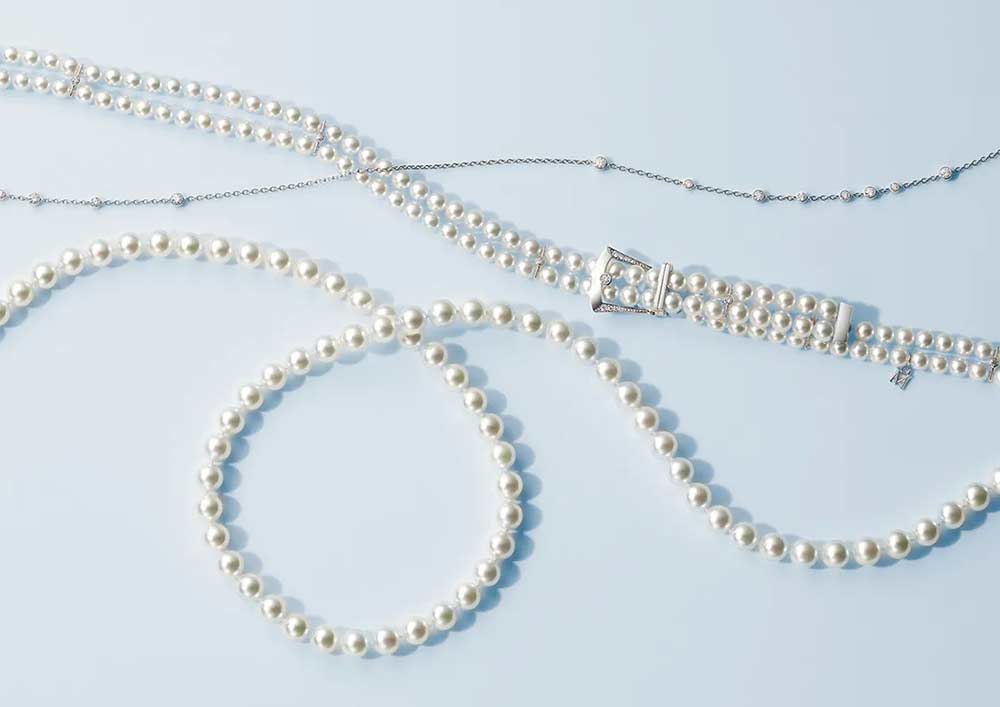How Are Mikimoto Pearls Graded?



Mikimoto pearls grading follows the five criteria in Mikimoto's proprietary system. The AAA, AA, A+, and A grading is stringent. Mikimoto has a culture of excellence through their grading system, emphasized when Kokichi Mikimoto set on fire substandard pearls in 1932.
To date, out of the hundreds of cultured pearls the brand scrutinizes, only 5% are selected as the best. Some of these are the most luxurious Akoya pearls. No wonder Mikimoto cultured saltwater pearls are highly valued.
The natural pearls fetch an even higher price since they are rare. It can take two to four years for a natural pearl to form. A mollusk only produces nacre three years into maturity, to expound on how hard it is to find a natural pearl.
Interestingly, natural pearls are mummified parasites! When parasites like the pearlfish swim into their shells and delicate bodies (to hide from predators), marine oysters and clams form layers and layers of aragonite and conchiolin.
They create nacre or the mother-of-pearl as a defense mechanism. Eventually, the oysters entomb the parasite wholly, forming a unique pearl. Other irritants are sand and dust.
We celebrate Mikimoto for discovering the classic Akoya variety. It has a perfectly round shape, mirror-like reflection, is white, classic, and is every woman's dream.
In this post, you'll discover what Mikimoto pearls are, the Mikimoto pearls grading system, and how to tell a genuine Mikimoto pearl from a fake one. Let's get into it!
What are the Mikimoto pearls?
Mikimoto is a brand named after the originator of cultured pearls, Mikimoto Kokichi. It has several lines of pearls, namely the Gordon classic collection, Zales signature collection, Blue Lagoon, Sea Magic, and Akoya Pearls synonymous with the Mikimoto brand.
Mikimoto creates jewelry from all pearl types. The five types of pearls are the Akoya pearl, black Tahitian, Sea of Cortez, Freshwater, and white and golden South Seas.
However, they are best known for the Japanese Akoya. The Pinctada fucata (martensii)-the scientific name for pearl oyster, which makes the Akoya pearl, lives in the cold waters of the Pacific Ocean around Japan.
Most pearls today are cultured. These genuine cultured pearls form after an irritant is introduced into an oyster.
In 1893, Kokichi successfully cultured the first Akoya pearl after trying many times to get a solution to end the harvesting of natural pearls, which were in high demand then. He was afraid the oysters would become an endangered species in Japan.
Pearls can come from any kind of mollusk, bivalved or spiral. They look different depending on the type of shell that made them.
The cultured pearls making process
In 1896, Mikimoto got a patent for his method of growing pearls. Cultured pearls are due to human intervention. Jewelers introduce an irritant, a beaded nucleus, and mantle tissue in the oyster's gonad, and in response, the oyster begins to produce pearls.
Baby oysters are nurtured on the Ojima, pearl Island, on the Ise coast for two years before being nucleated. The nucleation process is the most crucial part of making a pearl.
Mikimoto uses a small piece of mantle tissue from another oyster and a bead made from a freshwater shell in the nucleation process. Afterward, the oysters are put in oyster beds in a bay with calm water to heal.
The transfer of pearls to regions with strong currents and tidal exchanges is next. Here, they will be cared for as they grow into pearls.
The layering of nacre on pearls thickens dramatically over the winter months since the metabolism of the oysters slows down.
Harvesting and selecting cultured pearls
When it's time to harvest, the oysters are brought to shore and carefully opened. Harvesting of pearls is by hand.
These pearls are then sorted and graded. Mikimoto only selects the best gems to make Mikimoto jewelry always to maintain the highest standards and quality.
Mikimoto discovered that round pearls carved from mussel shells originating in America are ideal nuclei for round cultured pearls.
How thick the nacre is determines a pearl's luster or mirror-like reflection. Only the best quality and luster can carry the name Mikimoto pearls.
Mikimoto pearls grading system
The five-point grading system looks at luster, surface, color, shape, and size. Eventually, Mikimoto grades the pearls as AAA, AA, A+, or A. Grade AAA has a mirror-like reflection and close to no blemished surface. The AA is superb, with clear reflection and a slightly blemished surface. A+ is very good and A good.
Pearl luster
Pearl luster is the amount of light a pearl reflects or its glow. The surface quality and nacre thickness determine luster—the thicker the nacre, the better the luster.
It is generally possible to determine the longevity and quality of nucleated pearls by looking at the thickness of the nacre coating the surface of the pearl. The longer the pearls are allowed to develop, the thicker the nacre will become.
Surface and blemishes
Mikimoto looks at the blemishes or tiny marks on the pearl. Naturally, a pearl should have very slight blemishes.
Pearl color
Different pearls have different colors: creamy white, blue, green, gray, and black. Hard-to-find colors are more valuable, like the South Sea peacock green and gold shade pearls.
However, rich, evenly distributed, or matching colors are considered high-quality pearls.
Most people prefer creamy white with pink overtones or rose-pink Akoya pearls.
Pearl shape
Mikimoto aims for the best spherical pearls of premium quality. How close to a sphere the pearl is, determines its grading. Other shapes like baroque, oval, and teardrop are also famous for their uniqueness.
The diameter determines the pearl size
The size of the pearls depends on the diameter, typically in millimeters. Size does not affect the price tag but determines which outfit goes well with the neck pieces. Also, larger sizes are more valuable.
How to maintain your pearls grade
To prevent your pearls from becoming brittle and losing their color, keep them away from direct sunlight and do not store them in warm surroundings.
You should also avoid using airtight containers or bags for storage.
The pearls will stay hydrated if you add a wet cotton ball to the fabric pouch you use to store them.
Wear them regularly to keep them hydrated from your body oils, but wipe them with a soft cloth after each use.
Do not soak them in water for a long time; use running water and mild soap. Leaving the pearls in water for long affects the mother-of-pearl.
Because of their delicate nature (soft), you should keep your pearls in a separate material pouch to prevent damage from rubbing on other items.
How to distinguish genuine Mikimoto pearls
You will know Mikimoto pearls are authentic by looking for a trademark. Every strand has an oyster outline and a capital M inside the clamshell, engraved on the necklace's or bracelet clasp's underside.
Look for the trademark
For rings, look for the iconic M on the shank's inside. For earrings, look for the full name Mikimoto imprinted on the back of the stem. The writings might be too small, and you will need a magnifying glass to see them.
There is also a dangling metalmark M in newer pieces (bracelets and necklaces.
A necklace will have a double knot on each pearl to stop them from rubbing on each other and falling off fast if the necklace breaks. The clasp must also be an 18K gold clasp for newer pieces and a sterling for very old pieces.
Here are other things to check.
General pearl quality
Any evidence of thin or inconsistent nacre in Mikimoto cultivated pearls should be a red flag. Be wary when you find defects and inconsistencies on the surface or between pearls in a string.
Mikimoto artisans meticulously pair the pearls of Mikimoto to maintain their uniform size and flawless spherical surface.
Pearls should not look chalky white, and the brilliance of the luster must be evident.
The strand's material and quality
When buying a necklace or bracelet, check the strand to see how well it's threaded and the quality. Mikimoto commonly threads their pearls with a silk strand.
However, please note that vintage Mikimoto pearl necklace strands are likely restrung.
Have the pearls appraised
Expert jewelers can identify the distinct Mikimoto oyster outline with an M under a microscope. You can have them appraise your pearls and authenticate them, especially if they are a family heirloom.

Unfortunately, unscrupulous traders will attach the clasp to fake pearls and sell them at the price of genuine ones. So, you need to master the art of distinguishing them.
Conclusion
Mikimoto Pearls are graded based on luster, color, size, shape, and surface blemishes. The four grading systems are AAA, AA, A+, and A.
AAA pearls are exceptional and lustrous; you can see yourself in them. AAA pearls have close to no blemishes.
Grade A is the lowest grade but still high quality, and the pearls have slight blemishes and good luster.
Check out C.D. Peacock Mikimoto jewelry. You can never go wrong with the celebrity-endorsed and Chicago-approved jeweler who has been handling and selling jewelry since 1837.

